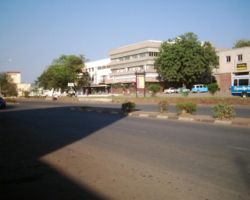Zambia
|
|
The English used in this article or section may not be easy for everybody to understand. (December 2011) |
|
Republic of Zambia
|
||||||
|---|---|---|---|---|---|---|
|
||||||
| Motto: One Zambia, One Nation | ||||||
| Anthem: "Stand and Sing of Zambia, Proud and Free" | ||||||
| Capital and largest city |
Lusaka 15°25′S 28°17′E / 15.417°S 28.283°E |
|||||
| Official languages | English | |||||
| Recognised regional languages | Chewa, Bemba, Lunda, Tonga, Lozi, Luvale, Kaonde, Nyanja | |||||
| Demonym | Zambian | |||||
| Government | Republic | |||||
| - | President | Edgar Lungu | ||||
| - | Vice President | None | ||||
| Independence | ||||||
| - | from the United Kingdom | 24 October 1964 | ||||
| Area | ||||||
| - | Total | 752,618 km2[1] (39th) 290,587 sq mi |
||||
| - | Water (%) | 1 | ||||
| Population | ||||||
| - | 2009 estimate | 12,935,000[2] (71st) | ||||
| - | 2000 census | 9,885,591[3] | ||||
| - | Density | 17.2/km2 (191st) 44.5/sq mi |
||||
| GDP (PPP) | 2009 estimate | |||||
| - | Total | $18.454 billion[4] | ||||
| - | Per capita | $1,541[4] | ||||
| GDP (nominal) | 2009 estimate | |||||
| - | Total | $13.000 billion[4] | ||||
| - | Per capita | $1,086[4] | ||||
| Gini (2002–03) | 42.1 medium |
|||||
| HDI (2011) | low · 164th |
|||||
| Currency | Zambian kwacha (ZMK) | |||||
| Time zone | CAT (UTC+2) | |||||
| - | Summer (DST) | not observed (UTC+2) | ||||
| Drives on the | left | |||||
| Calling code | 260 | |||||
| Internet TLD | .zm | |||||
The Republic of Zambia is a country in southern Africa. It shares its borders with the Democratic Republic of the Congo to the north, Tanzania to the north-east, Malawi to the east, Mozambique, Zimbabwe, Botswana, and Namibia to the south, and Angola to the west. It was called Northern Rhodesia and it is currently named after the Zambezi River.
The capital of Zambia is Lusaka, which is also the largest city in the country. Edgar Lungu is the current president. Its motto is One Zambia, One Nation and its national anthem is Stand and Sing of Zambia, Proud and Free. Its official language is English.
History[change | change source]
Zambia originated from Northern Rhodesia which was a colony of Great Britain. In 1965 Zambia became an independent country. The first president was Kenneth Kaunda, who ruled Zambia for 30 years with his party UNIP. Zambia was a one party democracy. UNIP was the only legal party and all other parties were banned.
After protests, democratic elections were held in 1991. Kenneth Kaunda lost the elections and gave away his power in an orderly manner to his successor Frederick Chiluba, a former union leader.
Zambia is now a multi-party democracy. It has had three democratic elections since 1991. The latest presidential election was in 2008, which was won by Rupiah Banda against Michael Sata.
Economy[change | change source]
In the 1960s, Zambia was making a lot of money because of the copper deposits that were mined in Copperbelt province. When copper became cheaper in the 1970s, the economy got worse because people in Zambia were not making as much money from selling copper.
Today, Zambia is a poor country. It does not have many industries. Copper is still its main export. Commercial farming in Zambia is starting to make more money.
Provinces[change | change source]
Zambia is divided into nine provinces. Each province is divided into several districts. There are 72 districts all together. The provinces are:
Cities[change | change source]
The important places in Zambia are:
| Cities in Zambia | |||||||
| Rank | City | Population[source?] | Province | Image | |||
| Census 1980 | Census 1990 | Census 2000 | Est. 2007 | ||||
| 1. | Lusaka | 735,830 | 1,069,353 | 1,684,703 | 2,146,522 | Lusaka |  |
| 2. | Ndola | 297,490 | 367,228 | 397,757 | 467,529 | Copperbelt |  |
| 3. | Kitwe | 283,962 | 288,602 | 363,734 | 409,865 | Copperbelt |  |
| 4. | Kabwe | 127,422 | 154,318 | 176,758 | 193,100 | Central |  |
| 5. | Chingola | 130,872 | 142,383 | 147,448 | 148,469 | Copperbelt | |
| 6. | Mufulira | 138,824 | 123,936 | 122,336 | 119,291 | Copperbelt | |
| 7. | Livingstone | 61,296 | 76,875 | 97,488 | 113,849 | Southern |  |
| 8. | Luanshya | 113,422 | 118,143 | 115,579 | 112,029 | Copperbelt |  |
| 9. | Kasama | 36,269 | 47,653 | 74,243 | 98,613 | Northern | |
| 10. | Chipata | 33,627 | 52,213 | 73,110 | 91,416 | Eastern |  |
Related pages[change | change source]
References[change | change source]
| Wikimedia Commons has media related to: Zambia |
- ↑ United Nations Statistics Division. "Population by sex, rate of population increase, surface area and density" (PDF). http://unstats.un.org/unsd/demographic/products/dyb/DYB2004/Table03.pdf. Retrieved 2007-11-09.
- ↑ Department of Economic and Social Affairs Population Division (2009) (PDF). World Population Prospects, Table A.1. 2008 revision. United Nations. http://www.un.org/esa/population/publications/wpp2008/wpp2008_text_tables.pdf. Retrieved 2009-03-12.
- ↑ Central Statistical Office, Government of Zambia. "Population size, growth and composition" (PDF). http://www.zamstats.gov.zm/media/chapter_3_population_comp._size_and_growth-_final.pdf. Retrieved 2007-11-09.
- ↑ 4.0 4.1 4.2 4.3 "Zambia". International Monetary Fund. http://www.imf.org/external/pubs/ft/weo/2010/01/weodata/weorept.aspx?sy=2007&ey=2010&scsm=1&ssd=1&sort=country&ds=.&br=1&c=754&s=NGDPD%2CNGDPDPC%2CPPPGDP%2CPPPPC%2CLP&grp=0&a=&pr.x=47&pr.y=15. Retrieved 2010-04-21.
|
||||||||




